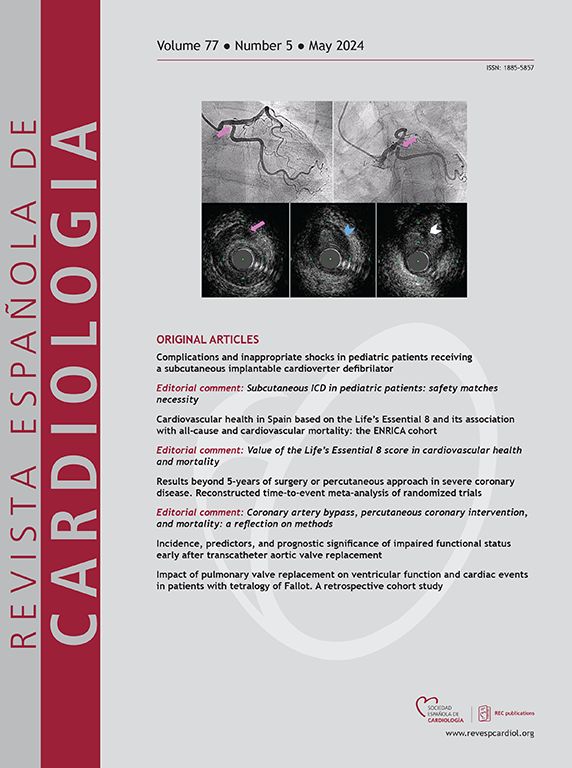关于分数血流储备引导下血管再通的随机和非随机研究的系统回顾和荟萃分析
IF 5.9
2区 医学
Q2 Medicine
引用次数: 0
摘要
导言和目的有几项研究调查了分数血流储备(FFR)引导在改善心肌血管再通术后临床疗效方面的有效性,但结果相互矛盾。本研究旨在比较冠状动脉疾病患者在 FFR 引导或血管造影引导下接受血管再通术后的临床疗效。方法纳入了随机对照试验(RCT)和非随机干预研究。主要终点为全因死亡、心肌梗死和主要不良心血管事件(MACE)。该研究已在 PROSPERO 注册(CRD42022344765)。FFR引导下的血管再通术与较低的全因死亡率(OR,0.63;95%CI,0.53-0.73)、心肌梗死(OR,0.70;95%CI,0.59-0.84)和MACE(OR,0.77;95%CI,0.70-0.85)相关。如果仅考虑研究性临床试验,则未观察到两种策略在任何终点上存在显著差异。然而,FFR的使用与血管再通率和治疗病变率的降低有关。元回归结果表明,与血管造影术相比,血管再通率越高的患者,FFR指导对减少MACE的益处越低(P = .012)。结论与血管造影引导相比,FFR引导下的血管再通术与较低的全因死亡、心肌梗死和MACE发生率相关,但RCT和非随机干预研究得出的数据相互矛盾。在血管重建率高、急性冠脉综合征患者发病率高的研究中,FFR引导的益处似乎不那么明显。本文章由计算机程序翻译,如有差异,请以英文原文为准。
Revisión sistemática y metanálisis de estudios aleatorizados y no aleatorizados sobre revascularización guiada por reserva fraccional de flujo
Introduction and objectives
Several studies have investigated the effectiveness of fractional flow reserve (FFR) guidance in improving clinical outcomes after myocardial revascularization, yielding conflicting results. The aim of this study was to compare clinical outcomes in patients with coronary artery disease following FFR-guided or angiography-guided revascularization.
Methods
Both randomized controlled trials (RCTs) and nonrandomized intervention studies were included. Coprimary endpoints were all-cause death, myocardial infarction, and major adverse cardiovascular events (MACE). The study is registered with PROSPERO (CRD42022344765).
Results
A total of 30 studies enrolling 393 588 patients were included. FFR-guided revascularization was associated with significantly lower rates of all-cause death (OR, 0.63; 95%CI, 0.53-0.73), myocardial infarction (OR, 0.70; 95%CI, 0.59-0.84), and MACE (OR, 0.77; 95%CI, 0.70-0.85). When only RCTs were considered, no significant difference between the 2 strategies was observed for any endpoints. However, the use of FFR was associated with reduced rates of revascularizations and treated lesions. Metaregression suggested that the higher the rate of revascularized patients the lower the benefit of FFR guidance on MACE reduction compared with angiography guidance (P = .012). Similarly, higher rates of patients with acute coronary syndromes were associated with a lower benefit of FFR-guided revascularization (P = .039).
Conclusions
FFR-guided revascularization was associated with lower rates of all-cause death, myocardial infarction and MACE compared with angiographic guidance, with RCTs and nonrandomized intervention studies yielding conflicting data. The benefits of FFR-guidance seem to be less evident in studies with high revascularization rates and with a high prevalence of patients with acute coronary syndrome.
求助全文
通过发布文献求助,成功后即可免费获取论文全文。
去求助
来源期刊

Revista espanola de cardiologia
医学-心血管系统
CiteScore
4.20
自引率
13.60%
发文量
257
审稿时长
28 days
期刊介绍:
Revista Española de Cardiología, Revista bilingüe científica internacional, dedicada a las enfermedades cardiovasculares, es la publicación oficial de la Sociedad Española de Cardiología.
 求助内容:
求助内容: 应助结果提醒方式:
应助结果提醒方式:


